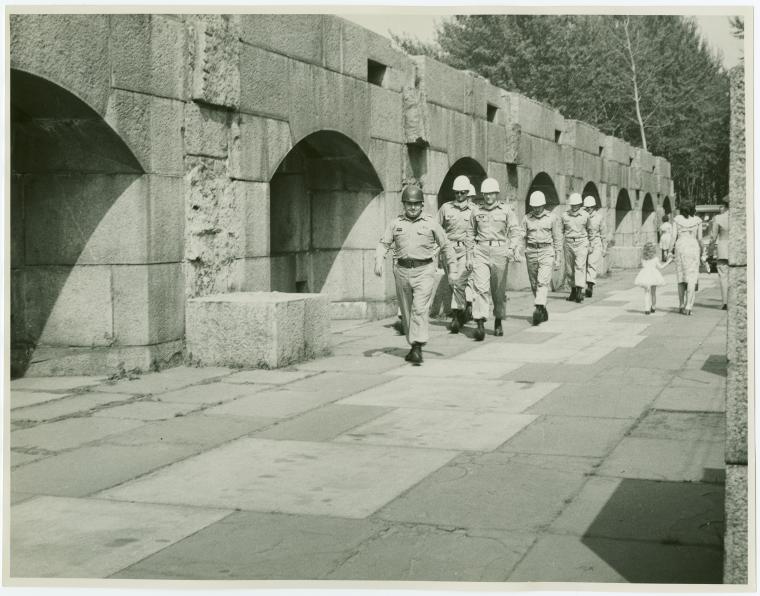Fort Totten Park

Amid the bloody brother war that tore the US in two, Fort Totten was being built with great haste to protect the New York Harbor. Just five years earlier, Congress approved the use of $155,000 to build the naval fort. Plans for the naval fort, including the series of fortifications that followed it, were drawn up by Captain Robert E. Lee, future General in Chief of the Confederacy.
Prompted by the onset of the Civil War, the Army Corps of Engineers began construction work in 1862. Upwards of 400 civilian laborers were hired to assist, with a pay of $3.00 per day ($92.31 in 2024). Thick granite blocks that make up its structure were ferried in by barges, specifically designed so that the exterior siding is rough while the interior siding is smooth.





Initially designed to be four stories tall, only two were ever completed before Congress halted any more progress in 1864. Continued work efforts proved to be irrelevant, as the fort had already become obsolete because of technological advances in weaponry made during the then-ongoing civil war.
Any further work was focused on improving its defensive capabilities. Additional construction in 1870 saw the creation of a tunnel linking the fort to the rest of the base, avoiding the specific targeting of ammunition reaching the frontlines.

Interest in the fort was once again renewed by the Spanish-American War, reigniting fears of a naval invasion by the Imperial Spanish Fleet. Ignited by patriotic fervor, President William McKinley renamed the fort in honor of Joseph G. Totten, Chief Engineer of the Army, in 1898. Around this time, he had become an integral figure in the development of naval fortifications. So much so that this is only one of three forts named in his honor, the other two are located in North Dakota and North Carolina.
Grapeshot ammunition along with the advent of snipers posed a significant threat to the crews operating the cannons, who often became engulfed in smoke after firing off a round. Iron shutters and the introduction of a ventilation system at each gunport were all innovative features meant to remedy previous issues.

The actual fort part of Fort Totten Park constitutes only a small fraction of the sprawling landscape. The total acreage for the property ranges from 170 to 93 acres of land, an unsuccessful attempt at selling 14 buildings was made in 1956.
Talks of granting the site surplus status were discussed in 1967, only to be delayed by further involvement in the Vietnam War. In its aftermath, discussions between the city and D.O.D. (Department of Defense) were renewed, an agreement was ultimately reached in 1977. Either deliberately or through pure coincidence, a majority of the older buildings were subsequently abandoned around the same time. Although abandoned, some such as the theater or hospital were used for the purpose of storage by both the Army and FDNY.





After 137 years of being an active army installation, the Department of Defense announced that Fort Totten was to be decommissioned in 1995. Garnering the interest of various groups and organizations, each with their own idea of what should be done with the former fort.
One group, the Matinecock tribal nation, claimed the property to be their rightful land. Supposedly, there's an ancient burial site on the grounds belonging to the tribe's ancestors. No recorded evidence supporting this claim was to be found either. With excavation being ruled out by the tribe's chief, Osceola Townsend, their claims were effectively rendered moot.
As it turns out, this was not the first time that someone had claimed to have an ancestor buried on the grounds. Tom Loggia is a descendant of the Wilkins Family, who had been one of the first families to settle in the area. That is until 1829, when the property was sold over to the Willets family. On the deed of sale, discovered by Mr. Loggia, a cemetery was listed in the contents section. Coordinates or any other identifying markers were not included in the deed, leaving Mr. Loggia to grasp at straws.
Potential prospects for the fort's future included an amusement park, shopping center, housing complex, and even a homeless shelter. Eventually it captured the attention of Columbia University, who wanted to create an on-site sailing center.
In between the long bureaucratic process of changing ownership to civilian control, the FDNY (New York City Fire Department) has acted as a caretaker for many of the 1960s-era townhouses since 1991. A training academy belonging to the department sits just a few feet away from the withering Dr. Walter Reed Hospital. Their track record when it comes to maintaining the buildings has always been the subject of scrutiny. After all, their goal is to save lives, not the preservation of historic sites.
Sometime between March 2008 to February 2009, multiple houses bordering the visitor's center were demolished. Likewise, 6 barracks constructed in the 1960s shared the same outcome. Two historic barracks designated as city landmarks were demolished last August, without any notice to the local community or the Landmarks Preservation Commission. Originally the demolition was scheduled for 2021, based off an emergency permit request made by the city that year. Since it was done under the guise of being an emergency, no notice or hearings were required.

Federal involvement led to the 49.5-acre park becoming property of the National Park Service. In 2004, it was handed over to the Department of Parks & Recreation on the condition that the space was to be for public use. Before it opened as a public park in 2005, it underwent several renovations regarding safety the previous year. A sum of $740,000 went towards installing new handrails, lighting, signage, and the opening of a visitor's center.
Remnants of its former life as an army installation evidently still remain to this day, and I'm not just refering to the buildings. Munitions from WWI were recently unearthed in 2023, part of the park was cordoned off as a safety precaution.


